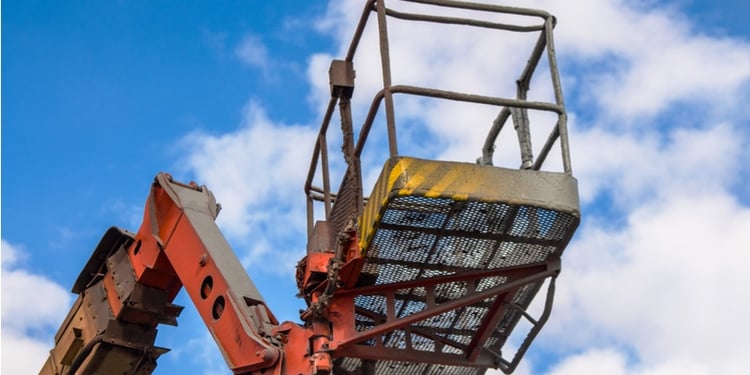Are you in charge of employee safety? Then, you’re probably already aware of the importance of fall protection. Employees in both general industry and construction need fall protection at some point - particularly those who have access to aerial lifts.
But do you know the OSHA requirements for wearing fall protection when working in a lift? There have been some misconceptions about the OSHA standards. This article will help you understand what’s required so you’ll know how to comply with the regulations.

Let’s first discuss the different types of aerial lifts. The two most common types of lifts are boom lifts and scissor lifts.
A boom lift is an articulating basket. It can maneuver employees in multiple directions. These lifts are convenient for accessing hard to reach areas and tight spaces. Boom lifts are sometimes also referred to as man baskets. This is because employees work out of small work platforms enclosed with guardrails.
A scissor lift is also enclosed with guardrails, but does not articulate like a boom lift does. Scissor lifts move in a straight up and down, vertical direction only. Scissor lifts are helpful for reaching heights and areas that are easier to access.
OSHA Standards
OSHA has different requirements for fall protection in aerial lifts. It’s important to know the difference between what’s required for a boom lift and what’s required for a scissor lift.
Boom Lifts

According to OSHA standard, employees must wear “a personal fall arrest or travel restraint system” when working from a boom lift.
Why do boom lifts require the use of fall protection? This is because there is a significant risk of employees being ejected from these types of lifts. When traveling across uneven surfaces, employees can catapult out of the lifts.
Keep in mind, the type of fall protection that OSHA requires is not a personal fall arrest system. It’s a personal restraint system.
Personal fall arrest systems protect an employee who experiences a fall. The systems limit the amount of force put on the employee and prevent them from reaching the ground.
But, a fall restraint system prevents the employee from experiencing a fall at all. Think of it as “leash” system. The restraint device only allows the worker to move within a certain radius. In this case, the radius is only far enough so that they can work from within the basket. But, it’s short enough so that they’re unable to climb up or out of the basket.
Scissor Lifts
There are no OSHA standards or requirements for wearing fall protection when working from a vertical scissor lift. That’s because with scissor lifts, there is no risk of catapulting out. The guardrails are enough to protect the employee from a fall hazard.

The exception to this rule comes into play when the guardrail system is “less than adequate.” This means the rails are missing, damaged, or otherwise insufficient for protecting employees.
Regardless, some scissor lifts have anchor points so that employees can properly use fall protection if desired. It’s not required. But, employees can choose to wear it so long as the lift has an ANSI-rated anchor point.
Using the Proper Equipment
What kind of fall protection equipment should your employees be using? Again, the intent is to prevent the worker from falling out of the basket. So, a fall restraint system is what they should use. This consists of either a body belt or a full body harness, and a positioning (also called 'restraint') lanyard.
Body belts are only allowed in fall restraint applications. Most employers prohibit the use of body belts altogether. This is so that employees don’t start using them improperly for other situations.
A full body harness is the preferred piece of equipment.
As for lanyards, the length is the most important factor you’ll need to consider. Remember: you want something short enough to prevent employees from climbing up and out of the basket. Adjustable length positioning lanyards typically provide the most comprehensive solutions in situations such as this.
You also want something that is practical for them to use. Make sure employees are using a positioning lanyard designed for restraint, and not a six-foot energy absorbing lanyard designed for fall arrest.
When considering anchor points, select a location approved for use in fall protection. It is NEVER okay to use guardrail as your anchor.
Discrepancies in Fall Protection Standards
There is one situation where an employee operating an aerial lift must wear a personal fall arrest system.
Is your worker using the lift to reach and access a roof or elevated work area? Then he or she needs a fall arrest system. Employees who transition from a lift to another platform face the risk of falling while climbing out of the lift and onto the other surface.
In this particular situation, employees will need to wear a “twin-legged lanyard.” This type of lanyard has two connection hooks. One attaches to the anchor point inside the lift. The other attaches to the anchor point on the roof or platform that the employee will access.
The proper way to use a twin-legged lanyard is to remain connected to the anchor point within the lift. This is true even while connecting to the new anchor point outside of the lift. This ensures “100% tie off” so that the employee is always connected to at least one anchor point.
Once the employee connects to the anchor outside of the lift, they can disconnect from the inside anchor. Employees should only connect to two anchor points during the transition period.
There is often confusion for what’s required while operating aerial lifts. That’s why, OSHA issued an interpretation letter that explains various requirements.
More Ways to Protect Your Employees
The risk of ejecting from an aerial lift is most prevalent when employees work outdoors or travel across uneven surfaces. Train your employees to do a pre-use inspection of the work area.
Things that employees should look out for include:
- Potholes

- Curbs
- Soft or wet ground
- Uneven or unstable ground
- Clutter or debris
- Weak flooring
- Grades and inclines
By avoiding these hazards, employees will significantly reduce their risk of ejection.
Wrapping it Up
We hope this article helped you understand what fall protection you need when working from aerial lifts.Avoid injuries by training your employees. They should be aware of each potential hazard of working from these types of lifts. Further, provide them with the proper fall restraint equipment. And be there to answer any questions they may have about how to use it.Are you on the lookout for more information on fall protection use? Visit our FAQ page today! There, you’ll find some bonus tips to help get you started.








